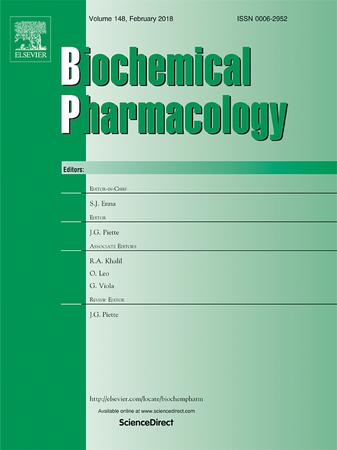糖尿病肾病中非编码 RNA 与细胞凋亡信号之间的相互影响
IF 5.3
2区 医学
Q1 PHARMACOLOGY & PHARMACY
引用次数: 0
摘要
糖尿病肾病(DN)是糖尿病终末期肾病的主要病因。因此,需要创新的治疗方法来延缓糖尿病肾病的发生和发展。高血糖可诱导多种肾细胞类型(如荚膜细胞、间质细胞和近端肾小管上皮细胞)发生细胞凋亡(一种细胞死亡的调节形式),最终导致 DN 的发病。最近的全基因组调查显示,人类基因组广泛转录,产生了大量调控性非蛋白编码 RNA(ncRNA),包括微 RNA(miRNA)和各种长非编码 RNA(lncRNA)。它们在维持生理平衡方面发挥着关键作用,而它们的失调则与包括 DN 在内的多种疾病有关。考虑到 DN 中细胞凋亡过程与 ncRNAs 表达之间已确立的联系,彻底了解它们之间错综复杂的相互作用至关重要。因此,本研究深入分析了 DN 发病机制中细胞凋亡背景下 miRNA、lncRNA 和环状 RNA 之间错综复杂的相互作用。此外,在最后一部分,我们证明了 ncRNA 介导的细胞凋亡调节可通过干细胞衍生的外泌体和草药实现,为治疗 DN 提供了潜在的途径。本文章由计算机程序翻译,如有差异,请以英文原文为准。

Crosstalk between non-coding RNA and apoptotic signaling in diabetic nephropathy
Diabetic nephropathy (DN) is a leading cause of end-stage renal disease in diabetes mellitus. It is also a significant contributor to cardiovascular morbidity and mortality in diabetic patients Thereby, Innovative therapeutic approaches are needed to retard the initiation and advancement of DN. Hyperglycemia can induce apoptosis, a regulated form of cell death, in multiple renal cell types, such as podocytes, mesangial cells, and proximal tubule epithelial cells, ultimately contributing to the pathogenesis of DN. Recent genome-wide investigations have revealed the widespread transcription of the human genome, resulting in the production of numerous regulatory non-protein-coding RNAs (ncRNAs), including microRNAs (miRNAs) and diverse categories of long non-coding RNAs (lncRNAs). They play a critical role in preserving physiological homeostasis, while their dysregulation has been implicated in a broad spectrum of disorders, including DN. Considering the established association between apoptotic processes and the expression of ncRNAs in DN, a thorough understanding of their intricate interplay is essential. Therefore, the current work thoroughly analyzes the intricate interplay among miRNAs, lncRNAs, and circular RNAs in the context of apoptosis within the pathogenesis of DN. Additionally, in the final section, we demonstrated that ncRNA-mediated modulation of apoptosis can be achieved through stem cell-derived exosomes and herbal medicines, presenting potential avenues for the treatment of DN.
求助全文
通过发布文献求助,成功后即可免费获取论文全文。
去求助
来源期刊

Biochemical pharmacology
医学-药学
CiteScore
10.30
自引率
1.70%
发文量
420
审稿时长
17 days
期刊介绍:
Biochemical Pharmacology publishes original research findings, Commentaries and review articles related to the elucidation of cellular and tissue function(s) at the biochemical and molecular levels, the modification of cellular phenotype(s) by genetic, transcriptional/translational or drug/compound-induced modifications, as well as the pharmacodynamics and pharmacokinetics of xenobiotics and drugs, the latter including both small molecules and biologics.
The journal''s target audience includes scientists engaged in the identification and study of the mechanisms of action of xenobiotics, biologics and drugs and in the drug discovery and development process.
All areas of cellular biology and cellular, tissue/organ and whole animal pharmacology fall within the scope of the journal. Drug classes covered include anti-infectives, anti-inflammatory agents, chemotherapeutics, cardiovascular, endocrinological, immunological, metabolic, neurological and psychiatric drugs, as well as research on drug metabolism and kinetics. While medicinal chemistry is a topic of complimentary interest, manuscripts in this area must contain sufficient biological data to characterize pharmacologically the compounds reported. Submissions describing work focused predominately on chemical synthesis and molecular modeling will not be considered for review.
While particular emphasis is placed on reporting the results of molecular and biochemical studies, research involving the use of tissue and animal models of human pathophysiology and toxicology is of interest to the extent that it helps define drug mechanisms of action, safety and efficacy.
 求助内容:
求助内容: 应助结果提醒方式:
应助结果提醒方式:


